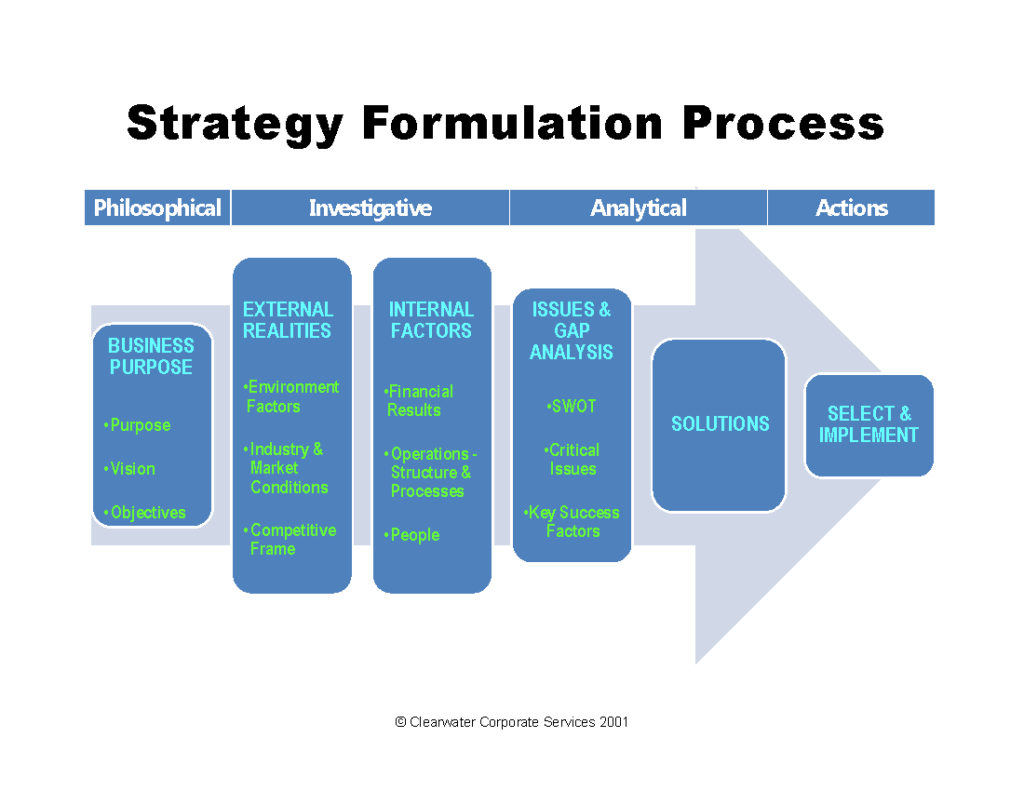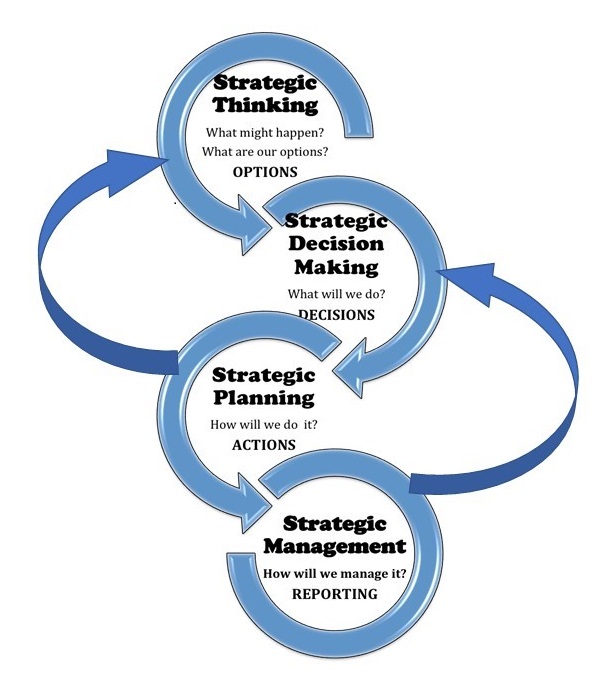Strategic thinking is becoming widely embraced as the rejuvenation of business strategy. It displaces tired and less effective Strategic Planning processes to better focus on building sustainable competitive advantage. These so-called ‘moats’ are essential building blocks for a bullet-proof business.
The Essential Business Strategy Formulation Process
Although different consulting groups and practitioners invent their own “unique methodologies”, they all share a fundamental backbone.
This consists of an analysis of the current situation (internal and external). This is sometimes referred to as a SWOT analysis. From a comparison with longer term ambitions (Purpose, Vision and Mission) a series of gaps are identified, together with potential actions to close. One of the keys is to identify sources of potential advantage. This in turn creates strategic direction.
The chart below shows the essential elements of any strategic formulation process – regardless of the alternate descriptors and nomenclature employed.
These essential questions underpin any framework:
- Who are we? Why are we here?
- Where do we want to go?
- What is happening around us that we can’t really control?
- What are we good at? Bad at?
- What do we need to get/have/do to get to where we want to be?
- What can we do?
- How will we do it?
The answers to these questions need to be made honestly and objectively. This is often where the process breaks down – due either to political or personal power sensitivities, or a myopic view of market dynamics.
Different levels within the organisation will generally provide different views of world realities, and customers and suppliers will hold their own disparate views.
Just as the competitive, economic and regulatory environment evolve constantly, so these questions should be considered regularly and repetitively. The quest for strategic insights is continuous.
Generic strategic planning processes have become widely used, with indeterminate results. It seems that everyone understands strategic planning, everyone does it, and all feel competent and knowledgeable about the process. Yet somehow the outcomes expected just don’t seem to emerge.
As a result, the corporate graveyard is littered with failed companies that just simply got it wrong. Therefore we must conclude that strategic skills are lacking amongst our management class.

Strategic Plans
Many so-called strategic plans are really little more than shorter-term operational plans to achieve this year’s budget targets. Often they are matched with a risk averse Board or Senior Management team. Others seem to be chasing unrealistic targets (or dreams) which have scant regard for dynamically changing external and environmental realities.
Strategic Planning is too often a “check the box” activity that fails to address honestly and openly the real challenges and changing circumstances of the organisation.
As a result, many strategic plans do not deliver focus;
- broadly stated mission, vision and values do NOT represent strategy;
- goals and targets are NOT strategies;
- historical reviews and forward projections are NOT strategies;
- budgets and clash cash flow projections are NOT strategies;
- SWOT analysis is an important input, but is often less than honest and often supports the status quo. It rarely reveals true distinctive competencies.
The Shift to Strategic Thinking
There is much written about business strategy and strategic planning – but there is also a great deal of misunderstanding. Most academics agree that traditional models of business strategy, primarily based on strategic planning, are not working. They conclude that there is a need for deeper levels of strategic thinking.
“While certainly not dead, strategic planning has long since fallen from its pedestal. But even now, few people fully understand the reason: strategic planning is not strategic thinking. Indeed, strategic planning often spoils strategic thinking, causing managers to confuse real vision with the manipulation of numbers. And this confusion lies at the heart of the issue: the most successful strategies are visions, not plans”
The Fall and Rise of Strategic Planning
Henry Mintzberg
Harvard Business Review January 1994
A strategic thinking framework enables firms to:
- find and develop unique opportunities to create value;
- challenge conventional thinking and assumptions about the current business model;
- better understand the fundamental business drivers;
- focus on strategic intent, which allows individuals within an organisation to marshal and leverage their energy, to focus attention, to resist distraction, and to concentrate as long as it takes to achieve a goal; and
- realise that strategy is not driven by future intent alone. It is the gap between today’s reality and intent of the future that is critical.
The fundamental truth behind all this is that unless a business can build a sustainable advantage over its competitors, it will not survive longer term.
Strategic thinking is laser focussed on building and maintaining these protective competitive “moats”.
“ Good strategic thinking uncovers potential opportunities for creating value and challenges assumptions about an organisation’s value proposition, so that when the strategic plan is created, it targets these opportunities. Strategic thinking is a way of understanding the fundamental drivers of a business and challenging conventional thinking about them, in discussion with others. Finally, strategic thinking is having an awareness of what has not yet taken shape, having foresight. “
The Fall and Rise of Strategic Planning
Henry Mintzberg
Harvard Business Review January 1994
Strategic thinking begins with the question “where are we going?”
The answer to this question creates the foundation of strategic direction and should remain relevant over the longer term. A typical timeframe is at least 5 years and it can stretch to 10 or 20 years.
To be effective, this vision has to be coupled with an in-depth understanding of future probabilities and insights into changing environmental factors and market dynamics. The intent is to develop relative strengths or unique advantages that can be sustainably exploited to outperform competitors.
Effective strategic thinking processes are best embedded into regular management processes.
By comparison, strategic planning is about managing resources rather than identifying ways to achieve desired outcomes. It is reactive, and is typically an annual exercise whereas strategic thinking is proactive and perpetual.
One of the key tests of strategy is whether it holds up or is abandoned in favour of short-term decision-making expediency. If an organisation is prepared to compromise its strategic direction or purpose in response to a short term situation, then I would argue that it doesn’t really have a strategy – and as Lewis Carroll’s Cheshire Cat said – “if you don’t know where you’re going, then any road will get you there.”

[Alice] began, rather timidly, `Would you tell me, please, which way I ought to go from here?’
`That depends a good deal on where you want to get to,’ said the Cat.
`I don’t much care where–‘ said Alice.
`Then it doesn’t matter which way you go,’ said the Cat.
`–so long as I get SOMEWHERE,’ Alice added as an explanation.
`Oh, you’re sure to do that,’ said the Cat, `if you only walk long enough.’
The 4 Elements of Busines Strategy
Strategy is one of those words which has become over-used and applied in many divergent circumstances. It can have many meanings. For clarity, we provide the following schematic to illustrate the different types of strategy which will apply to any organisation.

1. Strategic Thinking
Strategic thinking involves intuition and creativity. It generally results in an imprecisely articulated vision of direction.
Note also that this is an iterative process, as these questions need to be posed regularly, and suitable responses developed to fine-tune business plans and activities.
With a longer-term frame of reference, the intent is to reflect on possible future eventualities and possible responses. This doesn’t lend itself to scheduled timetables or precise definitions.
Insights are likely to come from within the organisation, at any level, and it is useful to encourage free-thinking by people at various levels who are deeply involved with specific issues at hand.
2. Strategic Decision-Making
Often over-looked in the management literature, no amount of strategic thinking or future visualisation will mean much if decisions are not made concerning the possibilities raised.
The decision may be to do nothing, but it is important that a decision is made. This involves a process of analysis, discussion, debate and action. This is often not a regular part of Board or Senior Management processes.
3. Strategic Planning
This is the bit that everyone is familiar with – the annual allocation of resources and responsibilities by which management pulls the strategy into reality.
Believe it or not, it is not uncommon for strategic plans to not mesh well with perceived vision, as it becomes fragmented by various management layers with (sometimes) competing priorities.
Processes which ensure alignment with strategic intent will lead to more effective strategy execution, and higher profits.
4. Strategic Management
The critical element of strategy is execution. It is important to ensure that it is aligned throughout the organisation. This should be contained within the strategic plan, but as mentioned, this is not always the case.
Where strategic thinking disciplines are promoted throughout the organisation, results are far better than when they are not present. The core question should be “what effect does this decision or action have on our overall aim of building our competitive moats, and on strategic direction?
There is also the challenge of remaining true to the strategic direction once determined, as there will be many short-term distractions. It requires strong leadership and continued reinforcement to maintain the focus on the core strategic intent.
The true test is strategic management is whether it is used by managers at different levels in the organisation (especially executives) to influence regular decision-making and resource allocation (is this consistent with our purpose, does this promote a longer-term strategic vision?).
David Shelton – Transition Capital
